 Elwin Hawthorne was born and lived in London, his wife the painter Lilian Hawthorn, his uncle part-time artist Henry Silk.
Elwin Hawthorne was born and lived in London, his wife the painter Lilian Hawthorn, his uncle part-time artist Henry Silk. Like them he showed with the East London Group at Lefevre Gallery, having studied from 1927 with John Cooper at the Bow and Bromley Evening Institute
Like them he showed with the East London Group at Lefevre Gallery, having studied from 1927 with John Cooper at the Bow and Bromley Evening Institute . the Group had achieved enormous, largely flattering press coverage, for its exhibitions, with the “Daily Mail” covering one show three times. Writing in the “Studio” in 1929 – as the Group forayed into the West End – F. G. Stone commented how its painters had found“beauty about the streets of the district that is known to the Post Office as E.3.” Just over a year later, the distinguished critic T. W. Earp
. the Group had achieved enormous, largely flattering press coverage, for its exhibitions, with the “Daily Mail” covering one show three times. Writing in the “Studio” in 1929 – as the Group forayed into the West End – F. G. Stone commented how its painters had found“beauty about the streets of the district that is known to the Post Office as E.3.” Just over a year later, the distinguished critic T. W. Earp in the “New Statesman” thought these artists “furnish the best exhibition of young English contemporary painting which has been shown in London this year.”
in the “New Statesman” thought these artists “furnish the best exhibition of young English contemporary painting which has been shown in London this year.” Early in 1933, American writer Helen McCloy in the “Boston Evening Transcript,” judged that “Never has there been so peculiarly English a group in modern art as these young workingmen” who had been able to convey
Early in 1933, American writer Helen McCloy in the “Boston Evening Transcript,” judged that “Never has there been so peculiarly English a group in modern art as these young workingmen” who had been able to convey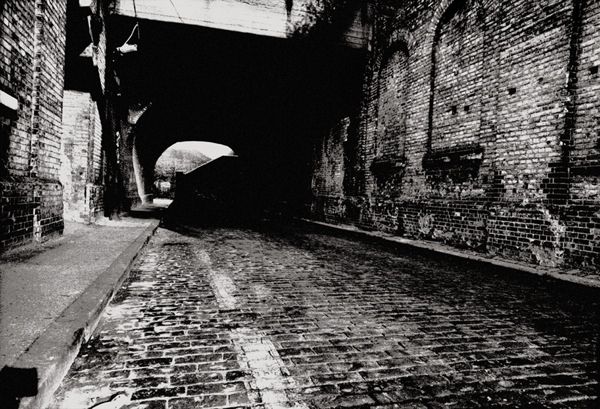 “the very spirit of the Cockney, the happy robust soul who is England.” By end, in 1936, when the Group was holding its eighth annual show at Lefevre Galleries, the “Sunday Times” termed it “the most interesting and promising of our younger art societies.”
“the very spirit of the Cockney, the happy robust soul who is England.” By end, in 1936, when the Group was holding its eighth annual show at Lefevre Galleries, the “Sunday Times” termed it “the most interesting and promising of our younger art societies.”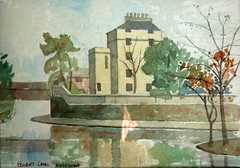
By then, John Cooper was middle-aged and had only a few years to live, dying in 1943. As a charismatic young painter from Yorkshire, he had inspired such raw material as errand boys, shopgirls, basket-makers and window cleaners to give up their precious spare time several days a week to attend his East End classes. below john cooper After teaching in Bethnal Green, he moved to a school in Bow where he attracted several dozen students. Many of these painters, showing as the East London Art Club,
After teaching in Bethnal Green, he moved to a school in Bow where he attracted several dozen students. Many of these painters, showing as the East London Art Club,  an exhibition at the Whitechapel Art Gallery in December 1928. This prompted Charles Aitken, its former director, then in charge of what is now Tate Britain, to display some of the pictures at the Millbank gallery early in 1929, and that show lead to the Lefevre Galleries series, provincial shows, participation in mixed exhibitions in Britain and abroad, plus solo shows for many of the members.cooper above and below
an exhibition at the Whitechapel Art Gallery in December 1928. This prompted Charles Aitken, its former director, then in charge of what is now Tate Britain, to display some of the pictures at the Millbank gallery early in 1929, and that show lead to the Lefevre Galleries series, provincial shows, participation in mixed exhibitions in Britain and abroad, plus solo shows for many of the members.cooper above and below
 After teaching in Bethnal Green, he moved to a school in Bow where he attracted several dozen students. Many of these painters, showing as the East London Art Club,
After teaching in Bethnal Green, he moved to a school in Bow where he attracted several dozen students. Many of these painters, showing as the East London Art Club,  an exhibition at the Whitechapel Art Gallery in December 1928. This prompted Charles Aitken, its former director, then in charge of what is now Tate Britain, to display some of the pictures at the Millbank gallery early in 1929, and that show lead to the Lefevre Galleries series, provincial shows, participation in mixed exhibitions in Britain and abroad, plus solo shows for many of the members.cooper above and below
an exhibition at the Whitechapel Art Gallery in December 1928. This prompted Charles Aitken, its former director, then in charge of what is now Tate Britain, to display some of the pictures at the Millbank gallery early in 1929, and that show lead to the Lefevre Galleries series, provincial shows, participation in mixed exhibitions in Britain and abroad, plus solo shows for many of the members.cooper above and below
At the 1936 Venice Biennale, two East London Group members, Elwin Hawthorne and Walter Steggles, participated alongside luminaries such as Frank Brangwyn, Barbara Hepworth, Gilbert Spencer and Philip Wilson Steer. Walter was one of the six surviving East London Group members that I traced, providing unique memories that otherwise would have died with him. When a small reunion was organized at Phyllis Bray’s house, Walter told her daughter Philippa - “John Cooper should have been decorated for what he did for artists.”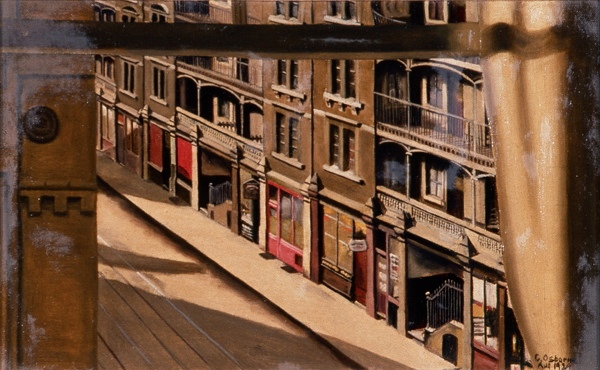

Walter, like his brother Harold, was grateful for the variety of teaching provided at Bow. John Cooper had been at the Slade School of Fine Art just after World War I and decided that a number of ex-Slade friends could aid his work and a few would later exhibit with the Group too. Phyllis Bray was one, William Coldstream another, but his real coup was to get Walter Sickert to make the trip into this unfashionable part of London to impart unique and often eccentric wisdom. Here was artistic royalty, and Lilian Leahy, who eventually married Elwin Hawthorne, recalled to me how as Sickert sat expounding, dressed in plus-fours and diamond-patterned socks, shopgirls would giggle with their hands over their mouths.
The East London Group website lists the thirty-five artists I claim as members. In addition to the history of the Group, the book contains biographical essays on more than twenty of these, including such colourful characters as Murroe FitzGerald, Irish Civil War death sentence escapee, eventually managing director in London of the Acme Flooring & Paving Co – and Albert Turpin, professional window cleaner, Anti-Fascist protestor and Labour mayor of Bethnal Green, whose passion was to record the disappearing End End that he grew up in. Yet many of the other members remain ghostly figures, despite my research into their personal histories.

As well as attracting Walter Sickert, John Cooper involve dozens of celebrities in his project. Charles Aitken encouraged the influential art dealer Joseph Duveen to buy paintings. Samuel Courtauld, Lord Melchett, Lord Burnham and the writer Arnold Bennett gave early financial help. Lady Cynthia Mosley and Osbert Sitwell opened exhibitions. The Prime Minister Ramsay MacDonald and Labour Party stalwart George Lansbury attended exhibitions and gave moral support. As their reputation developed over the years, the Group sold to influential collectors with the Lefevre Galleries welcoming extra, non-catalogue pictures, as sales rose and, on occasion, an exhibition’s term was extended.
As I investigated, I found that John Cooper and his Group became involved in more than exhibitions of paintings. It was these multifarious non-gallery activities that consumed my time, calling for detective work. It emerged that the Group was involved in making a documentary film about their activities. Also, members also painted pictures for stage plays and contributed to Shell’s popular range of posters. Phyllis Bray created three huge murals for the New People’s Palace in Mile End Rd and John Cooper revived mosaic teaching at the Central School of Art, becoming director of Courtauld-Cooper Studios and producing exciting Modernist work.
and John Cooper revived mosaic teaching at the Central School of Art, becoming director of Courtauld-Cooper Studios and producing exciting Modernist work.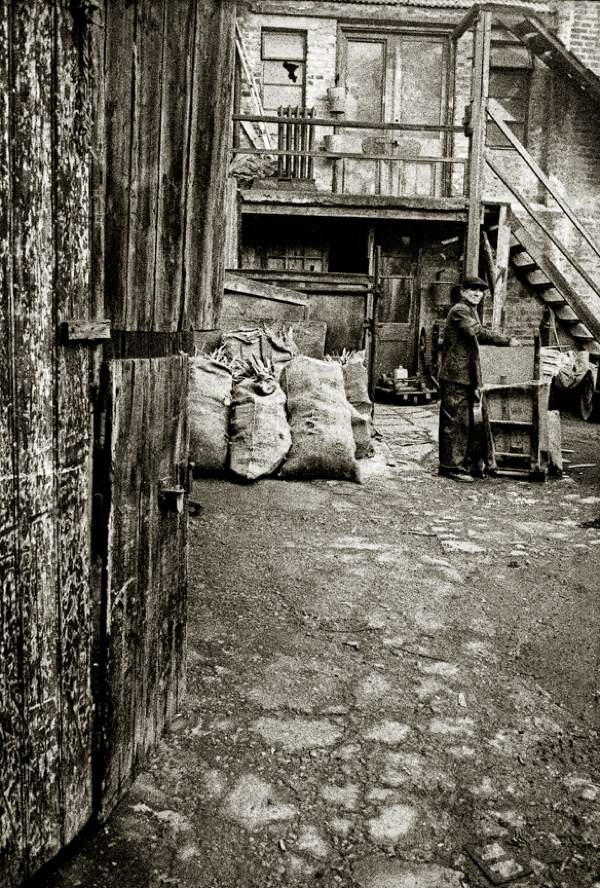
With such a large body of diverse work to its credit and dozens of works in public collections, the Group must take its place in any history of British Art in the first half of the century. Its omission would be scholarly negligence. And the story did not end with World War II as – thanks to the enduring inspiration of John Cooper – many members continued painting, long after the East London Group expired. Through the Group Hawthorn ('e' was initially a mistake in a review  and John Cooper revived mosaic teaching at the Central School of Art, becoming director of Courtauld-Cooper Studios and producing exciting Modernist work.
and John Cooper revived mosaic teaching at the Central School of Art, becoming director of Courtauld-Cooper Studios and producing exciting Modernist work.
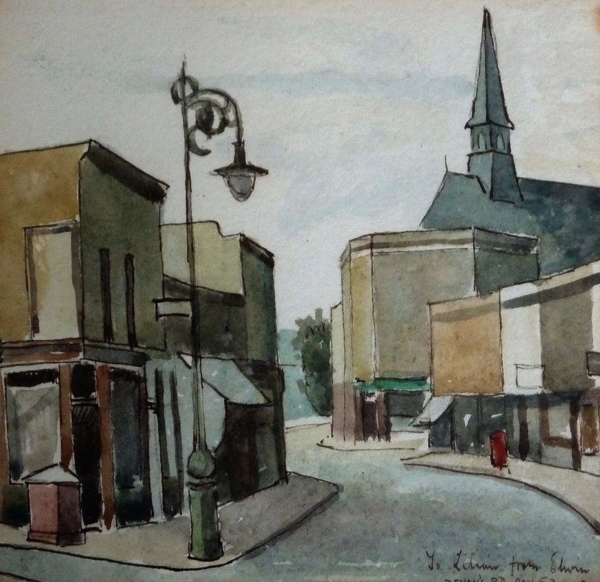 which Lefevre chose to retain) met Walter Sickert, whose studio assistant he was for three years.
which Lefevre chose to retain) met Walter Sickert, whose studio assistant he was for three years.  "The Guardian Angels Mile End Road, London E3"
"The Guardian Angels Mile End Road, London E3"oil on canvas, 14.5"x 17.5" two solo exhibitions with Lefevre in 1934 and 1938. Manchester City Art Gallery holds example of his work. Duke of Rutland
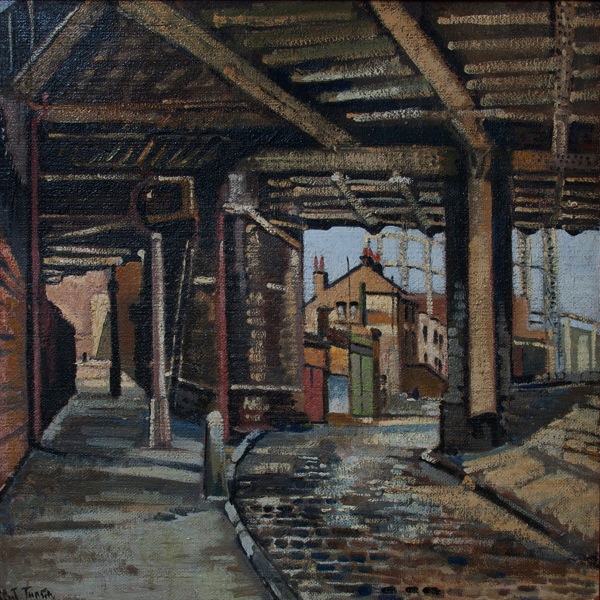 , Earl of Sandwich, Sir Edward Marsh, Charles Laughton and J.B. Priestley collected his work. (David Buckman Artists in Britain since 1945)Elwin Hawthorne’s widow,
, Earl of Sandwich, Sir Edward Marsh, Charles Laughton and J.B. Priestley collected his work. (David Buckman Artists in Britain since 1945)Elwin Hawthorne’s widow, 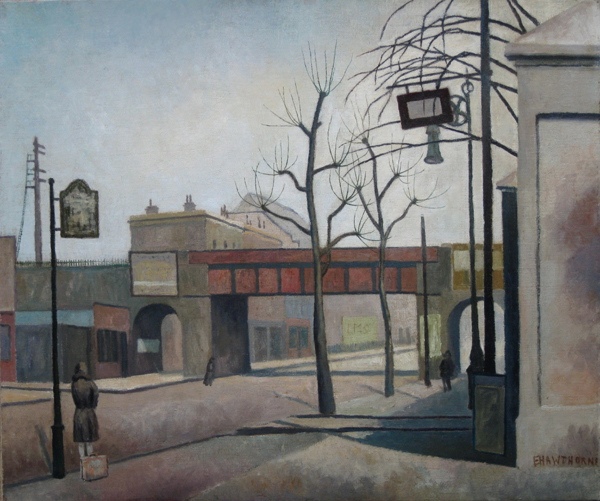 Lilian, then living in Vicarage Lane, East Ham.
Lilian, then living in Vicarage Lane, East Ham. 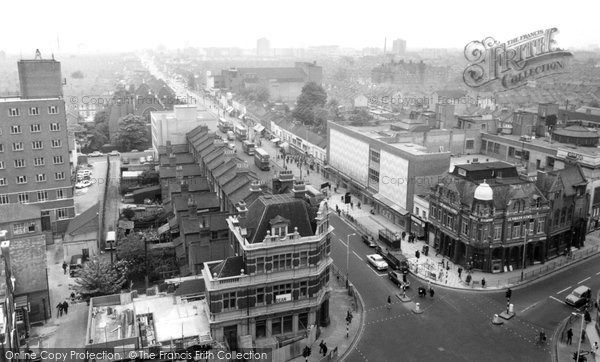 She had also exhibited with the Group, and provided invaluable memories of the triumphs and disappointments of her late husband’s career. Finally, when Lilian died in 1996, so unregarded was Elwin’s output that rescue work had to be carried out to save several pictures – two of these are among his paintings in my book.
She had also exhibited with the Group, and provided invaluable memories of the triumphs and disappointments of her late husband’s career. Finally, when Lilian died in 1996, so unregarded was Elwin’s output that rescue work had to be carried out to save several pictures – two of these are among his paintings in my book.In November 2008, when Sotheby’s auctioned pictures assembled by Sir David and Lady Scott, there was keen bidding for oils by Elwin Hawthorne. Sir David acquired a taste for the artist’s work in the early nineteen thirties when Hawthorne was a star exhibitor at Alex Reid & Lefevre’s galleries of work by the emerging East London Group.
Yet by the time of that Sotheby’s sale, Hawthorne was a forgotten name to all but a tiny group of enthusiasts who, like Scott, had been seduced by his melancholy, rather surreal views of London suburbs. The artist died in 1954, unremarked apart from family and friends, when he ought have been in his prime as a creative artist. Instead, disheartened by the lack of opportunities to exhibit, he had lost heart in his work.
While researching my book From Bow to Biennale: Artists of the East London Group, I was lucky to meet Elwin Hawthorne’s widow, Lilian, then living in Vicarage Lane, East Ham. She had also exhibited with the Group, and provided invaluable memories of the triumphs and disappointments of her late husband’s career. Finally, when Lilian died in 1996, so unregarded was Elwin’s output that rescue work had to be carried out to save several pictures – two of these are among his paintings in my book.
Elwin and Lilian moved into a newly-built block of flats in September 1953, only thirteen months before he died. Since the coal bunker had no shelf, Elwin used one of his fine oil paintings on board “Trinity Almshouses, Mile End Rd,” shown at Lefevre in 1935. After Elwin died, Lilian rescued it, filling in two screw holes with wood filler and painting over the damage. A canvas entitled “Ilfracombe” was also discovered in the coal bunker, rolled up and flattened like an old rag under a pile of rubbish – this has recently been professionally de-creased and mounted on a panel.
By the time of his death, Hawthorne had become a versatile artist, competent in oils, watercolour and printmaking, though his career as a painter in oils, his main achievement, was concentrated in just fifteen years, 1925-40.
Born in the Bromley sub-district of Poplar in 1905, to a father who was house painter and decorator, his background was not auspicious for what he wanted to do. Elwin, his parents, five brothers and a sister and a basket-maker uncle, Henry Silk ( another member of the East London Group), lived hugger-mugger in a small, crowded two-storey building.
When Elwin left elementary school at fourteen with no qualifications, he became an errand boy. While unemployed he developed an interest in painting which led to classes at the Bethnal Green Men’s Institute and then the Bow & Bromley Evening Institute where the teacher was the inspirational John Cooper who was trained at the Slade School of Art.
Although he originally showed under his correctly spelled surname of “Hawthorn,” when his work was chosen for the 1928 Whitechapel Art Gallery East London Art Club exhibition, the forerunner of the East London Group Lefevre series at in the West End in the nineteen thirties, he was catalogued as “Hawthorne” and urged to retain that spelling.
He became a prolific exhibitor at Lefevre Galleries’ annual exhibitions and elsewhere, and attracted widespread press attention. When the first East London Group show was held late in 1929, R R Tatlock, writing in the Daily Telegraph, devoted three paragraphs of a large review to Hawthorne, praising the subdued palette that would become an abiding characteristic of his work. At the second Lefevre exhibition in 1930, The Times judged Hawthorne, “the most original artist of the group, producing pictures of East London which are the English equivalents – though more matter of fact – of what Utrillo is doing for Paris.” In fact, Hawthorne was compared to Utrillo several times .
In 1930, Lefevre signed a contract with Hawthorne to pay him a modest salary of eight pounds monthly in return for a first-refusal option on his work, with financial adjustments to be made as pictures sold. At this time. Elwin was about two years into a three-year period as assistant to Walter Sickert, who had lectured to Cooper’s Bow classes and exhibited with the East London Group for a short period. Sickert had taken an interest in Hawthorne, who supported the veteran artist on several important works.
Hawthorne was a full-time artist of great professionalism and some of his meticulous work sheets survive, including details such as each painting’s title and size, descriptions of the subjects, prices and whether sold or returned, or – in a few cases – destroyed when they did not fulfil his high standards. In the case of one work, there is the inscription, “Returned to me, now in the possession of Steggles, by exchange.” His fellow in the East London Group, Walter Steggles, thought highly of Elwin, commenting to me, “It is my opinion that Elwin was the best painter of London in the Twentieth Century. I am not alone in this view as a number of important collectors have expressed similar opinions to me.”
Notable collectors of Elwin’s work were abundant. In 1938, as well as Sir David Scott and his Foreign Office colleague Montague Shearman, Hawthorne was able to list among his buyers the “Contemporary Art Society, Earl of Sandwich, Viscount D’Abernon, Earl of Radnor, Earl of Rutland, Sir Edward Marsh, Gerald Kelly RA, J B Priestley, Charles Laughton, James Agate and numerous others.” Today, eight public collections in Britain hold Hawthorne paintings.
After signed the contract with Hawthorne which would continue for most of the nineteen thirties, Lefevre realised they had a star whose pictures were not restricted to the annual East London Group exhibitions. He was included in mixed shows both in Britain and overseas, and was given two Lefevre solo exhibitions.
His first was in 1934, coinciding with one by Vanessa Bell of the Bloomsbury Group, with her work accompanied by a foreword by Virginia Woolf in the catalogue. Hawthorne’s was well received, The Times critic commenting on his “discovery of artistic meaning in the commonplace.” Meanwhile, the Sunday Referee’s writer, who contended that “Mrs. Woolf’s mystical flutings on the theme of her sister’s paintings simply bewilder” yet found Bell’s work, “essentially commonplace.” The critic judged Hawthorne “an outstanding, possibly great artist in the making” and praised his display as “easily the best one-man show in town.”
In 1938, a second solo exhibition followed, but this time in tandem with one by Sickert’s third wife, Thérèse Lessore. Leading critics covered it, including T W Earp, Jan Gordon and Eric Newton. Again, Hawthorne’s work was generally favoured, with the critic of The Scotsman – who had liked his first solo show – seeing in his small pictures, “an impression of complete sincerity that is rare and inspiring.”
By this time, Hawthorne’s figure painting was developing yet even in one of his early works from 1929 – the picture of the Bryant & May Match Factory which proved a favoured subject for East London Group artists – the handling of the figures is assured. For his fellow East London Group member Cecil Osborne, the absence of figures in Hawthorne’s work, gave them “a ‘Sunday Morning look” with the sparsely populated streets contributing to their surreal quality. John Cooper was keen that his students visited exhibitions and it is possible that Hawthorne may have viewed the controversial 1936 International Surrealist Exhibition at the New Burlington Galleries, although a surreal atmosphere had already permeated Hawthorne’s work years earlier.
Hawthorne had other preoccupations in 1936. Along with Walter Steggles, he had a painting chosen for the British pavilion at the Venice Biennale, with a contribution entitled “Una Via Di Londra.” It was a great accomplishment for a former errand boy to have his work shown alongside professional artists such as Sir Alfred Gilbert, Duncan Grant, Dame Barbara Hepworth and Philip Wilson Steer. Also in 1936, The Artist included a lengthy, illustrated profile of him as the twelfth in its “Artists of Note” series, beginning by extending “our special gratitude” to John Cooper, since “it is the East London Group that has given us Elwin Hawthorne”.
Although the final East London Group exhibition at Lefevre was in 1936, the gallery continued to promote individual artists’ works until World War II brought disarray to the art market. The hostilities effectively ended Hawthorne’s exhibiting career. After Army service, for which he was temperamentally unsuited, he returned to Lefevre, but they had nothing for him and suggested he take a job. He handled wages for radio and electronics firm Plessey, teaching art in schools part-time. Then, in 1954, he was taken ill on a bus to Woodberry Down School and died soon after in hospital. Elwin Hawthorne was only forty-nine, and he left a widow and two children – and he created a body of atmospheric paintings that survive to be acknowledged and appreciated now for their distinctive vision.
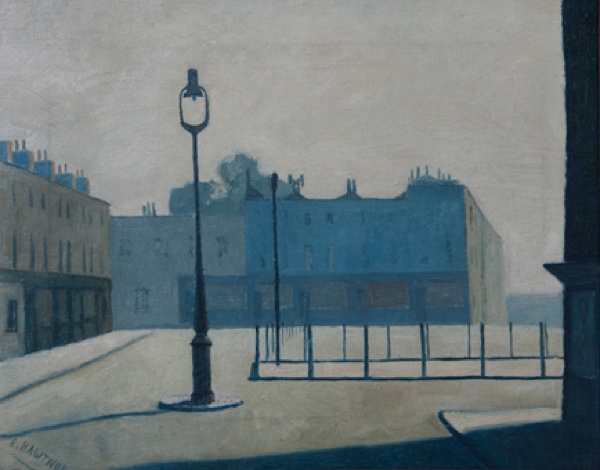
Cumberland Market, 1931 (Private collection)
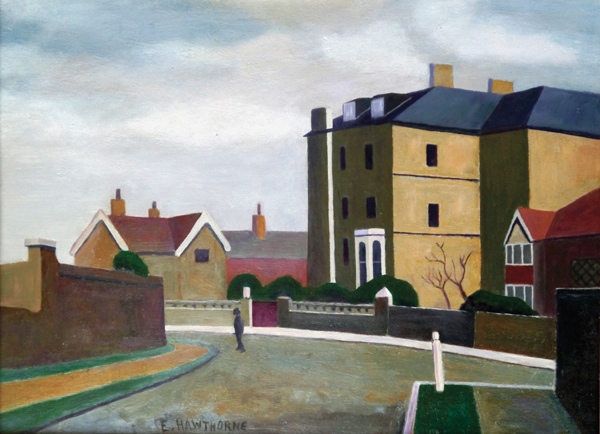
Grove Park Rd W4, 1935 (Private collection)

Whipps Cross, 1933 (Gabriel Summers)
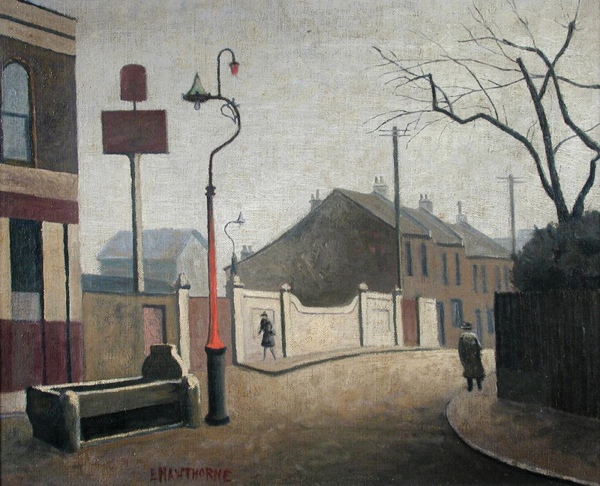
The Mitford Castle, 1931 (Private collection)

Bow Rd, 1931

Victoria Memorial Buckingham Palace, 1938 (Private collection)
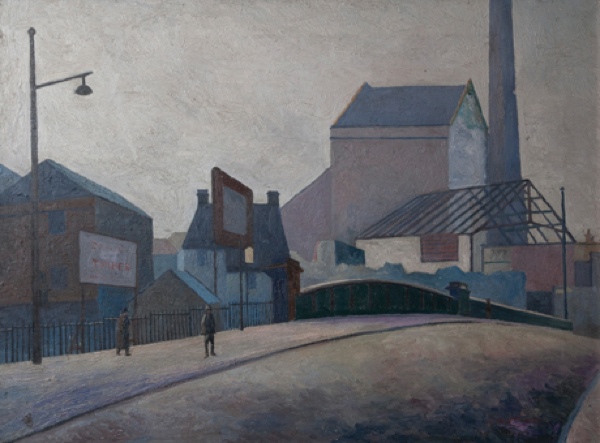
Demolition of Bow Brewery, 1931 (Private collection)
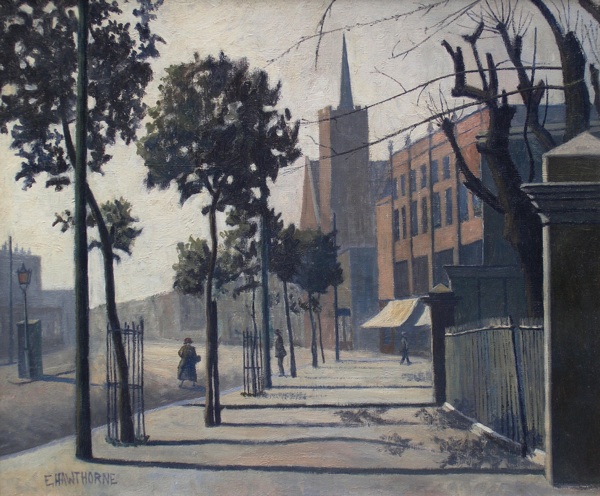
The Guardian Angels, 1931 (Louise Kosman, Edinburgh
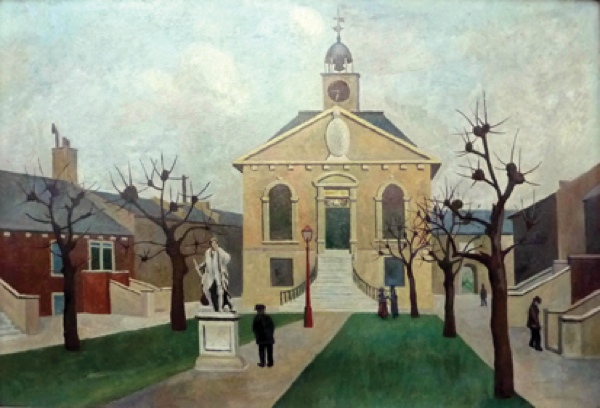
Trinity Almshouses, Mile End Rd, 1935 (Private collection) - rescued from use as a shelf in a coal bunker.
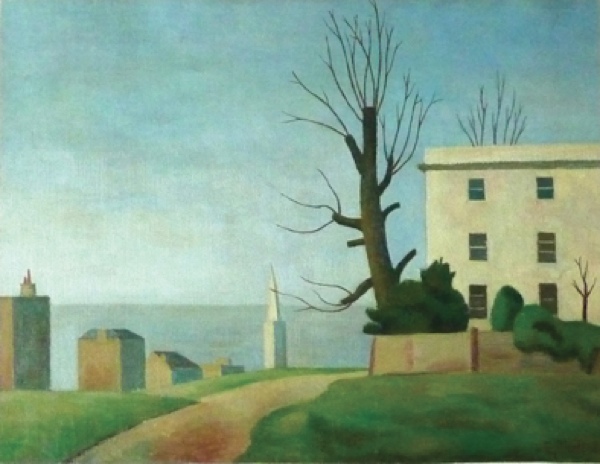
Ilfracombe, c.1931 (Private collection) – discovered rolled up in the coal bunker.
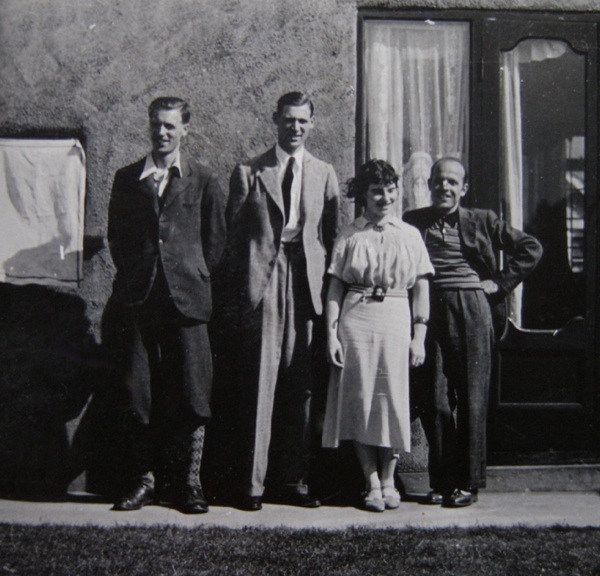
Walter and Harold Steggles, Lilian and Elwin Hawthorne (right), c.1937 (
From Bow to Biennale: Artists of the East London Group by David Buckman can be ordered direct from the publisher Francis Boutle and copies are on sale in bookshops including Brick Lane Bookshop, Broadway Books, Newham Bookshop, Stoke Newington Bookshop and London Review Bookshop.
Hi, I really like the images here, great to see all the paintings!
ReplyDelete